
“No child should feel unwanted. I shed a tear behind the camera. Showing emotions is important as a journalist,” Kathryn Carlson told around 150 DC students over Skype in the National Geographic auditorium on Wednesday, May 29. Carlson was speaking about the Pulitzer Center-supported film she edited, A Widow's Torment, which was screened during the presentation. Students from DC International, MacFarland Middle School, Center City PCS Congress Heights, and Center City PCS Capitol Hill, learned about storytelling and documentary filmmaking from a team of educators, journalists, and editors.
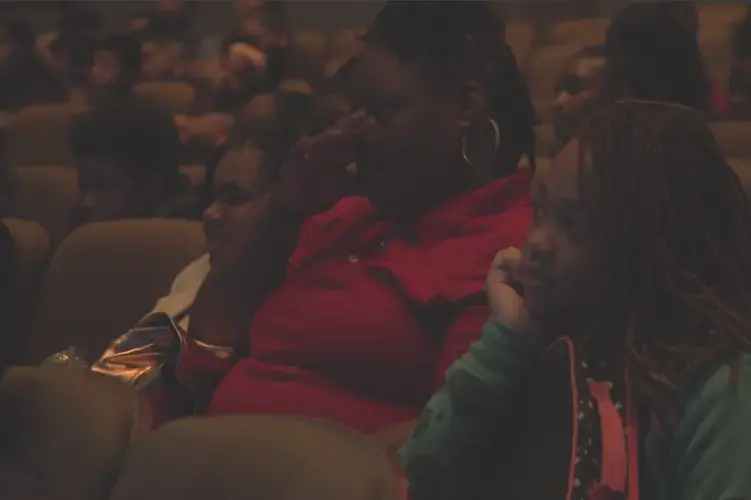
Before the presentation, during pre-visit workshops at each of the schools earlier in the week, students had learned about telling stories through a singular viewpoint, how news gets published, and the role of the Pulitzer Center in bringing global and local stories to news outlets. The Pulitzer Center education team, supported by journalist Dominic Bracco, visited the participant classes to prepare them for the field trip. Bracco explained aspects of filmmaking, such as a-roll (auditory) and b-roll (visual) footage, and students spotted these techniques while watching Dying to Breathe, a digital news story by grantee Sim Chi Yin, following the slow death of a gold miner due to air pollution in the heartland of China. The students would put these skills into action later in the week as they began to develop their own narrative films.
As a reminder of their pre-field trip learning, Senior Education Manager Fareed Mostoufi asked the students filling the National Geographic auditorium what kinds of stories the Pulitzer Center supports. Students exclaimed in unison, “Under-reported stories!”
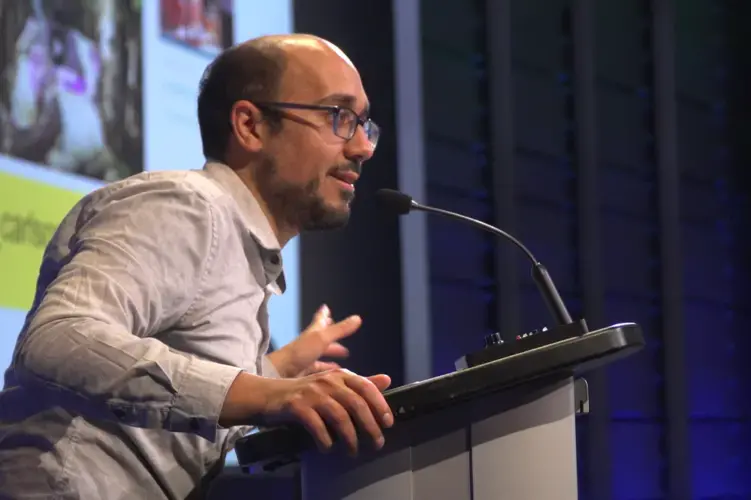
Celeste Harrison, educational events specialist, introduced the students to National Geographic’s mission: “We believe in science, storytelling, and education to change the world.”
Brenna Maloney, managing editor of National Geographic Explorer, a magazine for children in grades K-5, spoke of “the magazine as a microphone.” She explained that the stories in the magazine are based on “real science, coming from the real world.” She described National Geographic Magazine’s evolution: At its founding it was more like a pamphlet, without the vibrant photography that is now one of its calling cards. Additionally, Maloney said the magazine’s audience has changed: “We stopped writing for the elite, and started writing for everyone.”
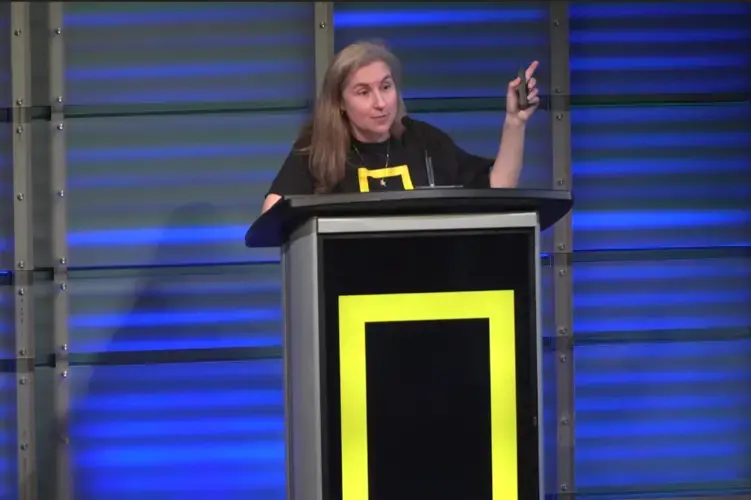
She showed students a slideshow of National Geographic photos—starting with a photo of journalist Cory Richards in Pakistan on an expedition. She explained that he took the selfie right after crawling out of an avalanche. “He wanted to share this with us as a piece of what he was going through,” she said. Students saw pictures of David Dugulay exploring the world’s oceans, and Albert Lim riding across China on a horse during an archeological expedition. “All of these explorers have the same goal: to help you learn about our planet and how to protect it. They tell you what it’s like to be there…what it tastes, smells, sounds like.”
Throughout the visit, techniques of single-subject storytelling were emphasized. Students watched A Widow’s Torment, a film by grantee Kathryn Carlson about a widow’s struggle to claim legal rights to her land in Uganda. The film illustrated the story of Betty Nanozi over the 11 years of her widowhood. Nanozi describes how her husband’s children from a previous marriage robbed her of everything twice, threatening the life of her son, their half brother.
After the screening, Mostoufi asked the students what they felt was most powerful or affecting about the film. One girl raised her hand and noted the different culture depicted in the film, where women have to fight for their own land. Another student was struck by the way the film “presented the pain.” Kayla, a student at MacFarland, was saddened “seeing many widows robbed and threatened to be killed.”
Students then watched Diego’s Rebirth, a film made by grantee Dominic Bracco, following the life of former gang member Diego Montejano as he oscillates between his two personalities—"El Oso" (the Bear) and Diego—and tries to rise above cycles of violence in Juarez, Mexico. “I have the potential to do many good things and to help people,” Diego says in the film, looking down at the concrete.
After watching the film, students reflected on what they saw. “The film showed me how you can change your community, and you don’t have to be in cycles of violence anymore,” Kayla said.
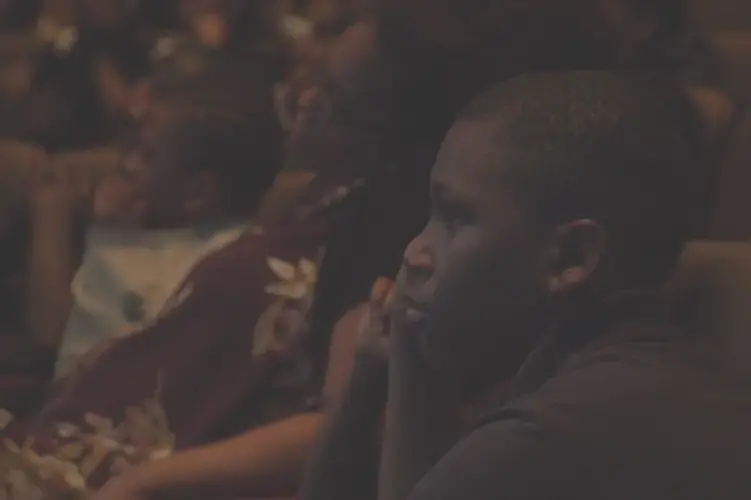
Dominic Bracco then joined Mostoufi on stage to discuss the process of making Diego’s Rebirth. “How many of you have felt mad?” he asked the students, most of whom raised their hands. The personal side of violence is what Bracco hoped to explore in his film through the character of Diego. The anger and chaos we feel is personal, he expanded, but for Diego was rooted in societal systems beyond his control. On the whole, violence in Juarez had been decreasing, and Bracco wanted to understand this change through a singular story.
“Diego’s parents worked in factories and were violent,” Bracco explained. “Being with Diego, it’s frustrating to see how much his environment frames his life.”
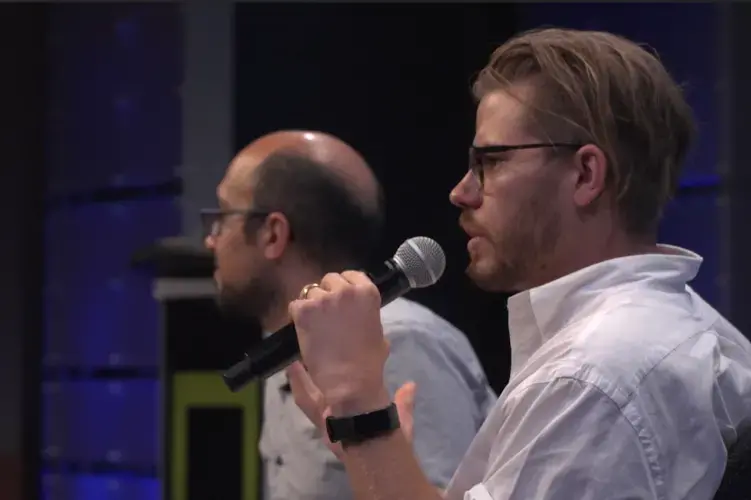
“Did you ever talk to him about moving away from the toxic community?” one student asked from the audience.
“It’s complex because Diego...he doesn’t wanna leave, it’s his home, his community. It’s hard to leave where you came from.” Bracco spoke about growing up in south Texas on the border, where he witnessed gun and gang violence often. The issues explored in the film that Diego faced were personal to Bracco too.
Bracco explained the way he obtained footage for the film. He and his team spent time in Diego’s house, allowing Diego to feel comfortable. In the film, Diego is seen writing on a piece of paper, which is something Bracco said Diego would often do.
Students were curious about the barriers that Bracco and Carlson encountered in shooting their films. The main barrier for Bracco was financial, when he realized Diego’s story was much bigger in scope. “We went to the Pulitzer Center, which funded the project,” he said.
Carlson, who edited A Widow’s Torment, spoke to students via text and a prerecorded video. She said she struggled with the emotional components of filming, especially during the scene with the boy standing over a grave.
She elaborated on the crucial parts of creating a film. "Find someone comfortable being on camera, and then plan the shots," she said. “Find all the visuals that would represent the story correctly, and ask questions with emotional language.”
In the next two days, Bracco returned to each school to talk more with students about narrative filmmaking. Students wrote scripts about their own lives, applying the techniques of single-subject storytelling they learned about through watching and discussing A Widow’s Torment and Diego’s Rebirth.
In the post-visits, students created their own short scripts telling the stories of pivotal moments in their own lives. With Bracco, they discussed what goes into creating a film plan and how to use literal and metaphoric visuals when trying to convey emotions.
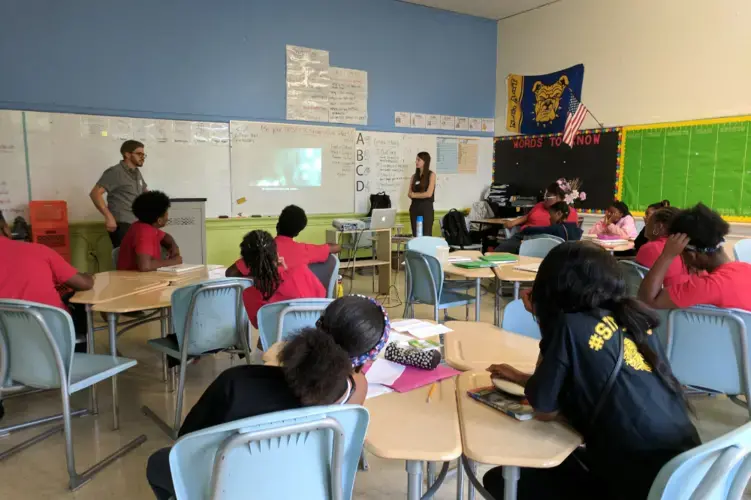
Students separated their scripts into a-roll and b-roll footage, accompanying a sentence of description with an image they thought could represent that portion of their narrative. One student wrote about how the birth of her younger brother has affected her life. “My life changed when my little brother was born. My parents said there would be someone else when I went to the hospital to see the baby. When it happened, I felt so surprised cause I had been alone for a while and now I love my little brother and care for him a lot," she wrote under the a-roll column.
In pre-visits, the National Geographic field trip, and post-visits, students explored the stories of their own lives, visualizing how the most personally impactful moments to them might look like on a screen to a viewer.
As her story unfolded, the student envisioned that the viewer would see, in sequence: "the camera pointing at the back of my head looking at the sun; a picture of my whole family; running inside a hospital, and my parents hand on my shoulder; me playing all by my self; me holding my little brother."

Project
A World of Widows
When grief is compounded by cruelty: Societies of widows, battling the stigma of exclusion and the...

Project
China: Dying to Breathe
China’s deadly mining accidents hit the international news headlines frequently. But the country's...













